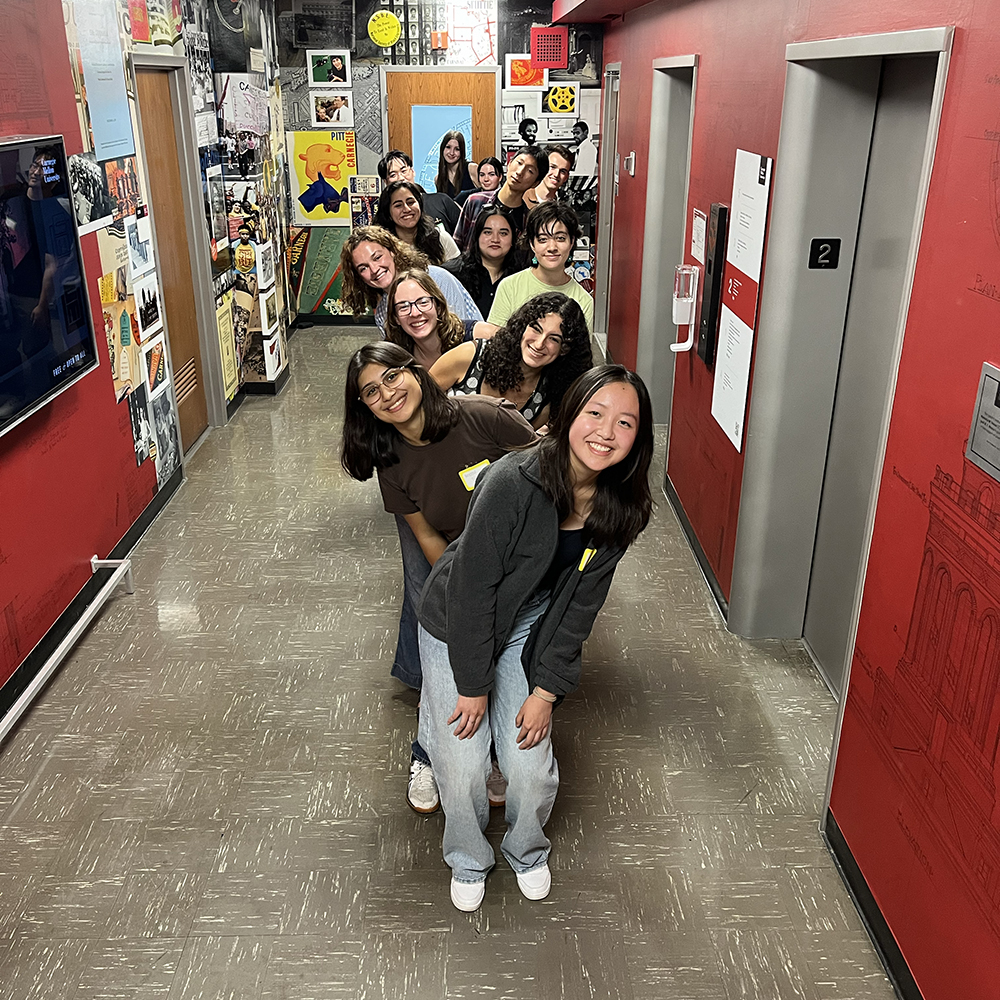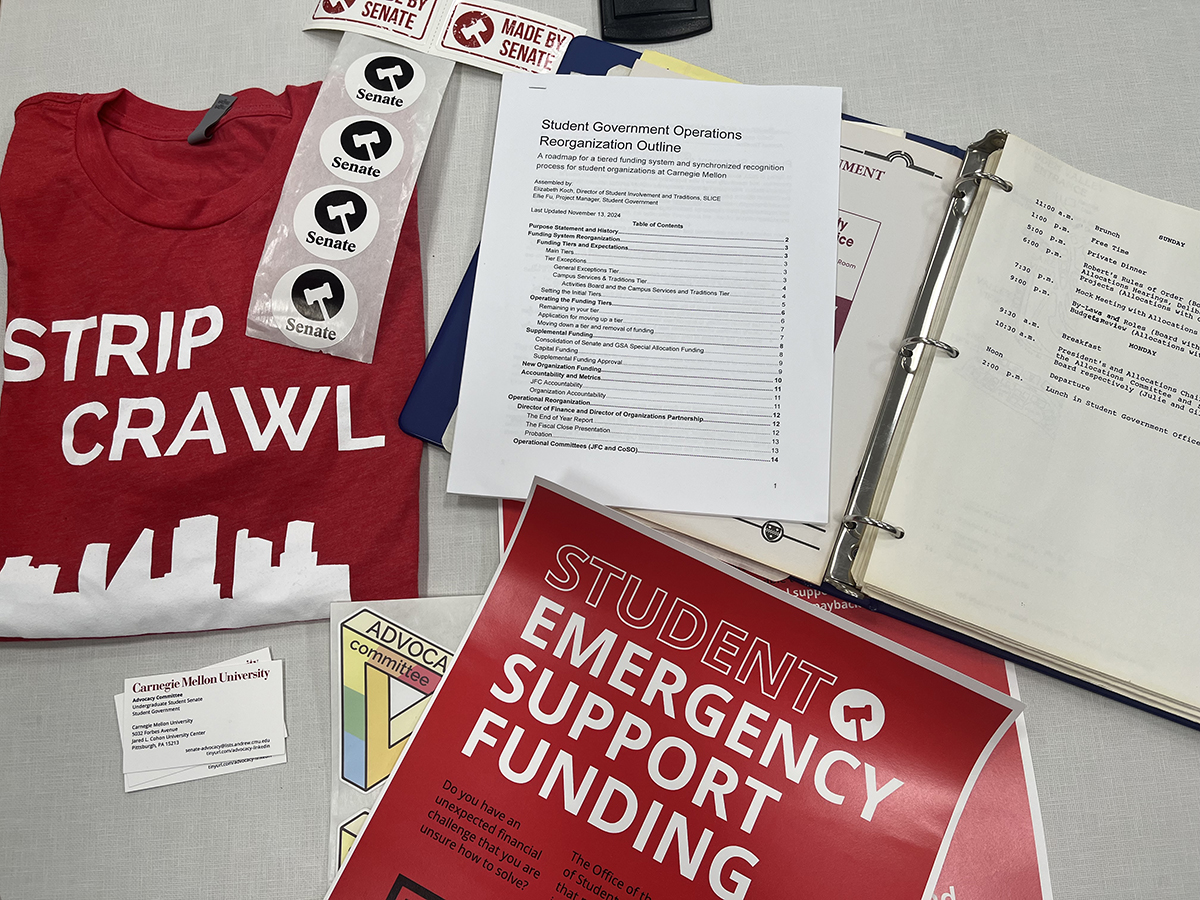
By Sarah Bender and Ramsha Naveed
As the 2025 spring semester comes to a close, the 2024-2025 Libraries Student Advisory Council (LSAC) is putting the finishing touches on their year-long archiving project to collect and preserve artifacts from student groups on campus. On Tuesday, April 22, join LSAC from 5–7 p.m. in Hunt Library’s IDeATe Studio B as they showcase primary sources and other historic materials in “Living History: Tracing CMU Culture Through Student Organizations.”
Student organizations are a key aspect of the culture of Carnegie Mellon, and the University Archives preserves their living histories within the decades of records and materials contained in its collections. Diving into these materials can help us not just understand CMU overall, but also learn how student life has played an active role in shaping it into the institution that it is today.
“Student organizations are such a vital part of campus because they are created by and for the students,” said LSAC member Emily Manack, a sophomore in Dietrich College of Humanities and Social Sciences. “They are an accurate window into what being a CMU student is like.”
Since September, LSAC has worked closely with the Archives team as Archives Ambassadors. At early meetings, Community Collections Processing Archivist Crystal Johnson shared important aspects of an archivist’s role in the CMU community, from building connections across campus and teaching groups to care for and organize their own materials, to transferring materials into the Archives for research and preservation. She also shared examples of items from student organizations already in the Archives collections, including digitized copies of the student newspaper, The Tartan, Scotch’n’Soda Theatre programs from the 1940s, and WRCT technical logs and Carnegie Tech Radio Club postcards from contacts around the world.
“Archiving is important to me because archives exist — and will continue to exist — as invaluable resources for generations to come,” explained first-year Bachelors of Humanities and Arts (BHA) student Amanda Barajas. “These physical repositories offer an interactive experience for learning about CMU history; every artifact has a story to tell, no matter how big or small. Working directly with these materials alongside my peers and the Archives team has been such a rewarding part of being in LSAC.”
 After training, council members started getting in touch with various student organizations, building relationships with the groups and spreading the word about the importance of preserving present-day CMU history by collecting key materials that document their activities.
After training, council members started getting in touch with various student organizations, building relationships with the groups and spreading the word about the importance of preserving present-day CMU history by collecting key materials that document their activities.
Selecting materials to donate to the Archives also served as a way for student groups to reflect on their organization’s efforts over time and gain new insights into their work.
For Natalie Sarabosing, a junior studying statistics and data science and human-computer interaction and former vice president of the Catholic Newman Club, contributing to the project provided an opportunity to celebrate the past. “I found myself marveling at the creativity of the events that they held, and wondering if we could take inspiration from our past,” she said. “Donating new material felt like putting in a little slice of our history for future years to find. From posters to shirts, it’s cool to think that our everyday items will eventually be part of a much larger narrative of CMU’s faithful Catholic community.”
Heinz College of Information Systems and Public Policy graduate student Belen Torres, a member of LSAC, got the opportunity to participate in this experience as well. She became the editor-in-chief of the Heinz Journal during the course of her work with LSAC, and began looking into the journal’s history on campus. She discovered that it was created as part of a Heinz student’s capstone project to provide a platform for their peers to publish their work. Torres chose to donate some of her group’s artifacts “to honor these efforts and to preserve a snapshot of what students cared about at this moment in time, helping future generations learn about our contributions.”
Torres added, “In our LSAC meetings, we often talk about celebrating student life and preserving living histories. I think the Heinz Journal perfectly encapsulates that mission. It reflects the voices, research, and passions of Heinz students, and I’m excited that it will now have a place in the archives."

These materials from student organizations are the core of the event, offering a glimpse of the impact these groups have had at CMU from past decades through the present. Displays created by LSAC members will present an array of physical and digital materials from groups like the Undergraduate Student Senate, the Catholic Newman Club, and Radical Alliance for Gender Equity (R.A.G.E.).
At the event, members of today’s student organizations will also have a special chance to contribute to their group’s archival records. LSAC will provide cards, markers, and collage materials for attendees to record their reflections about groups they are a part of at CMU.
This activity is designed to encourage current students to preserve their own memories for future generations by engaging with the Archives. It’s also a great opportunity for newer student organizations to start building up archival material documenting their early days on campus.
“This archiving project and celebration of our past and present is exciting because it allows us to uncover and showcase the vital work of student organizations, which often serve as anchors for community building,” said Dietrich graduate student and LSAC member Ramsha Naveed. “I hope this initiative will allow us to create stronger connections across diverse groups on campus, and inspire future students to get involved in student life on campus as well.”
Stop by “Living History: Tracing CMU Culture Through Student Organizations” from 5–7 p.m. on Tuesday, April 22. Registration is not required, and food will be provided.
